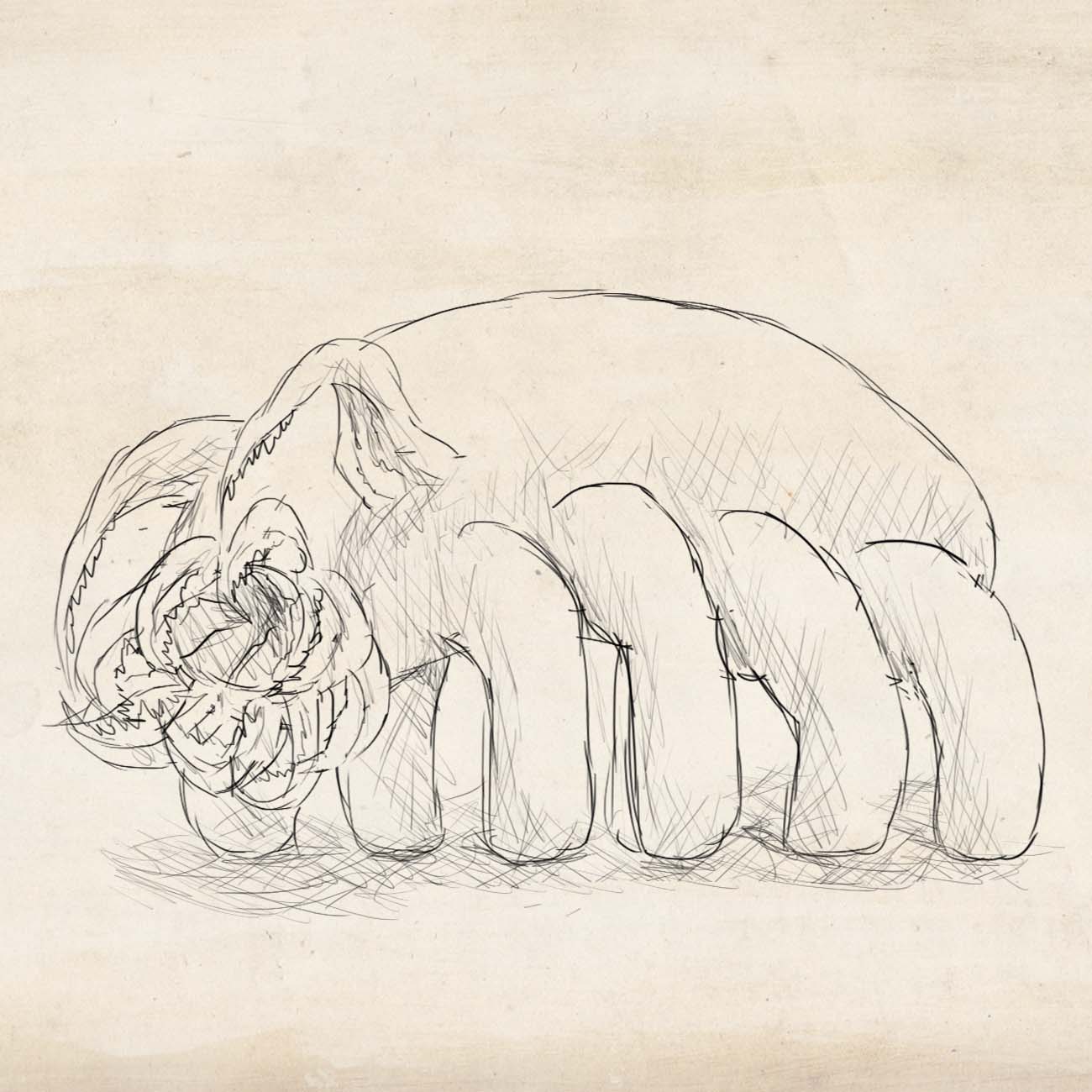Sea Boar
Sea Boars are gigantic, placid filter feeders, known for being some of the largest creatures in the Nightlight Zone. They travel together in teams, and have a very simple life of traversing over the seabed in search of sufficient crowds of plankton. The only real threat they face are the sand storms that often form in the Fields. Their large sizes appear to make easy targets for rocks being flung by the storms.
Basic Information
Anatomy
Sea Boars have extremely soft bodies with no structure made to stiffen it, or create joints. Their faces only consist of two thick antennae and a large mouth ringed by tentacles, with bristles on their underside for filtering plankton from the environment. They support themselves with eight legs that function similarly to hydraulic pumps, moving in a slow synchronous fashion.
Genetics and Reproduction
When these creatures first reach adulthood, they'll leave their team and travel on their own for a while, until they meet another of their kind by chance. The two will mate as soon as possible, fertilizing their gametes through a special arm they keep stored in their mouths. They give birth to live young, but only produce one offspring at a time, expanding their team extremely slowly over the rest of their lives.
Growth Rate & Stages
Sea Boars start out as very pudgy, with short legs and feeding arms. They will live under their parents' protection for most of their youths, and as their siblings are born, they'll help in protecting them along with the parents. The only skills these creatures really need to learn are walking and staying coordinated with the team, and knowing to avoid intense currents. In adulthood, they won't change much besides their reproductive arm becoming longer and more flexible to be able to leave their mouth.
Ecology and Habitats
Sea Boars are found in the Fields and travel just about anywhere, oftentimes unknowingly destroying the terrain underneath them. Their tracks leave a huge impression on their environment, with their legs able to crush most rock formations, as well as destroying nests and any plants that get in their way. It has been theorized that their clumsiness poses a significant threat to other species' territories, alongside the strong currents of their habitat.
Dietary Needs and Habits
Sea Boars will only eat a specific rare type of plankton that lives in the Fields, and they'll travel anywhere to get it. They feed on the plankton by creating a miniature whirlpool with their mouths, catching the plankton by waving their feeding arms everywhere, then enclosing them over their mouths and swallowing it.
Biological Cycle
Older members of this species usually have hardened clumps of sand stuck to the bottom of their feet, thought to accumulate simply from walking anywhere in their habitat. Their skin will also become less transparent overtime due to the sand, where babies are nearly see-through, and the adults appear more solid.
Additional Information
Social Structure
Sea Boars live in semi-large teams that are only made up of newly-started families. New adults will either stay with their team indefinitely or leave it, with those who leave starting their own team with other individuals they meet along the way. Some team members have been seen grooming each other and getting rid of debris that occasionally blow into their sides, and they'll attempt to protect one another in a sandstorm by placing themselves in front of their young, and taking blows for themselves. But, it is unknown if they truly care for each other beyond that.
Perception and Sensory Capabilities
Sea Boars don't have eyes, ears, or nostrils, but instead sense their surroundings with their giant antennae. The sensors lining the antennae's undersides can detect any surface for extremely long distances. Instead of watching out for predators, they mainly use their antennae to keep track of the team, and to avoid the mountainous regions of their habitat. They're also useful for detecting debris from a sandstorm.
Symbiotic and Parasitic organisms
Some small species will swim underneath these creatures in order to hide from predators, with some going inside their mouths as well. The Sea Boars are unable to swallow anything bigger than plankton, creating an ideal hiding place for these smaller creatures.
Scientific Name
Scotoplanes immane
Lifespan
Unknown
Average Weight
38,000 lbs
Average Length
60 ft.
Average Physique
Chunky
Body Tint, Colouring and Marking
Anywhere from white to dark grey
Geographic Distribution
Very low
Remove these ads. Join the Worldbuilders Guild










Comments